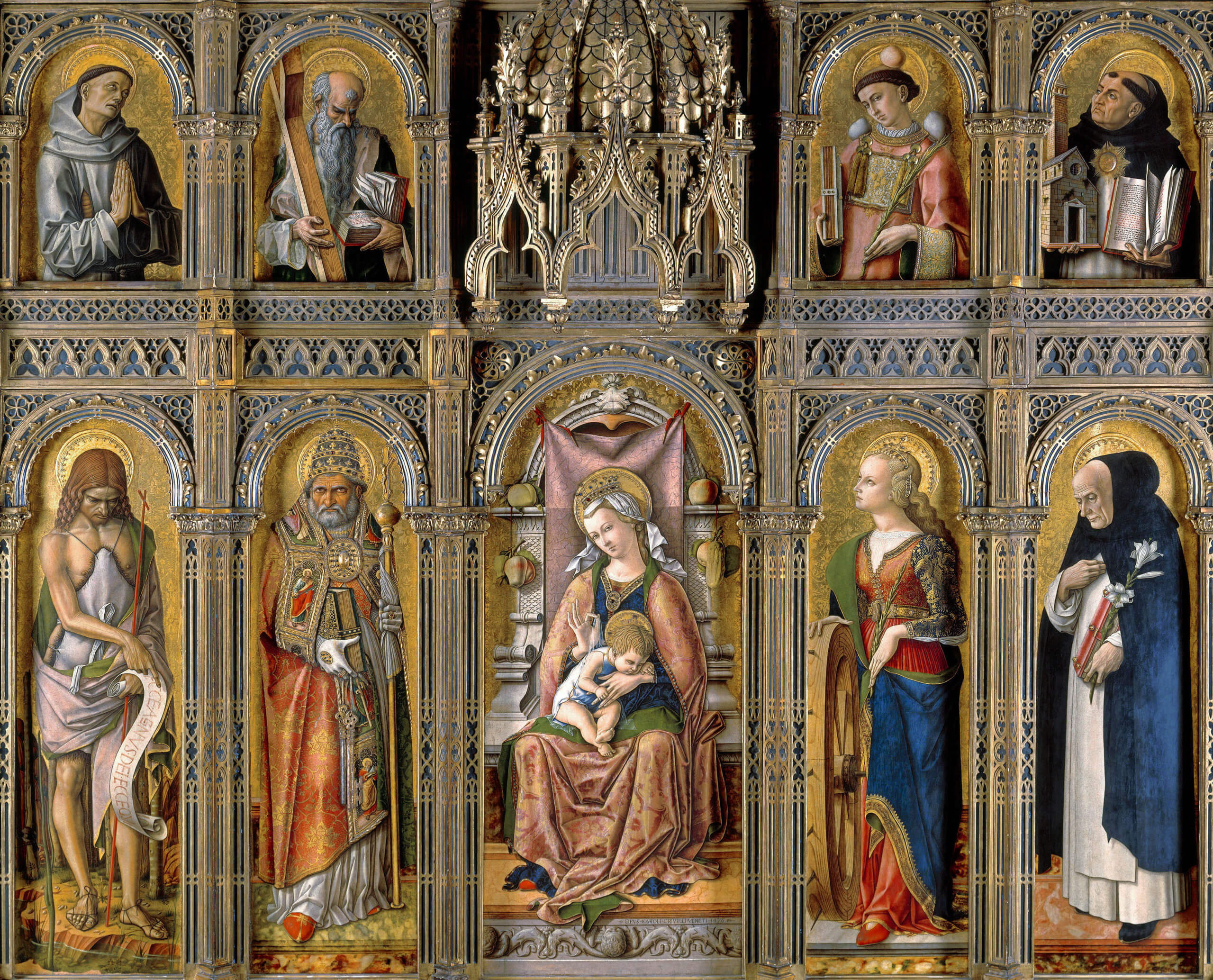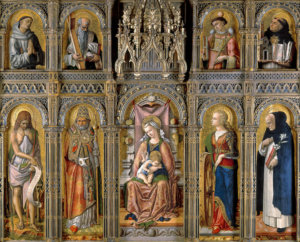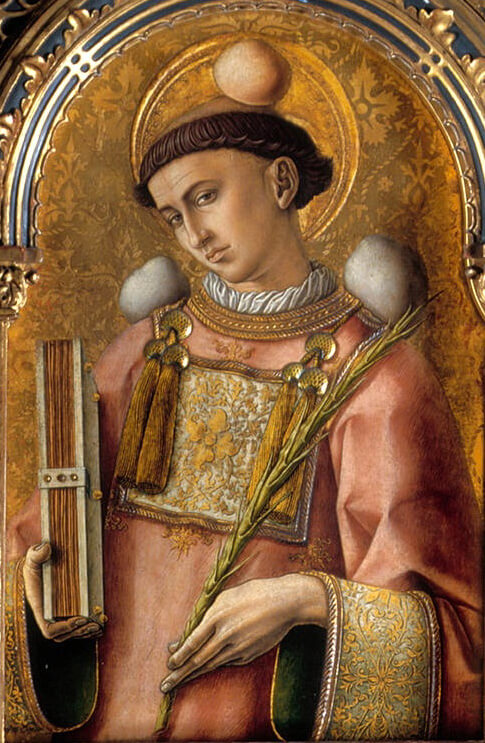The Crib, the Cross and the Crown
Above: the Demidoff Altarpiece, (Carlo Crivell, 1476). St. Stephen appears in the upper right corner next to St. Thomas: The Crib, the Cross and the Crown. These three objects serve different functions in the life of Christ and the reality […]


Above: the Demidoff Altarpiece, (Carlo Crivell, 1476). St. Stephen appears in the upper right corner next to St. Thomas:

The Crib, the Cross and the Crown. These three objects serve different functions in the life of Christ and the reality of our salvation and yet are intertwined in an incredible way. The Church draws our attention to these three realities in the life of Christ, of course, but also by the application of them in a new one, a proto or first. In this case the first martyr, St. Stephen.
December 26th is the feast day of St. Stephen, the great Deacon and Proto-Martyr. This date, which comes up on us as a great surprise – the second day in the Octave of Christmas, the “Second Day of Christmas” – contrasts the festive Christmas celebration that has peaked the day before.
The Christmas Spirit of the Christian
Our first witness or martyr, shows us the depths of the original Christian spirit and the true proper Christmas spirit. The Church uses her liturgical life to draw our eyes, before the Christmas feast is even finished, to refocus on suffering, sacrifice and that of course means the Cross. When discussing the role of the other feasts which are to come in the Octave, Dom Guéranger draws this out beautifully,
The place of honour amidst all who stand round the Crib of the new-born King, belongs to Stephen, the Proto-Martyr, who, as the Church sings of him, was the first to pay back to the Saviour, the Death suffered by the Saviour.
This is how the traditional liturgical calendar gives Catholics a spiritual lens in order to see the mysteries of our faith in a new way.
This is truly the Christian, Christmas spirit.
We sentimentalize the celebration of the infant birth and his victory without St. Stephen, without the awareness of the approaching sacrifice. In essence, we lose the true joy of the Crib when we lose the true horror of the Cross.
Baby Jesus is born and immediately laid upon…wood. The wooden manger. And immediately the Church gives us the glorious crown of St. Stephen.
By highlighting St. Stephen the Church is moving us immediately into this reality – from the cry of the infant Christ in the Crib to Stephens very own cry the next day:
Lord, do not hold this sin against them.
Again, from ‘The Liturgical Year’ Dom Guéranger draws this out with a stunning quote,
The Church gives us, in to-day’s Office, this opening of a Sermon of St. Fulgentius for the Feast of St. Stephen: “Yesterday, we celebrated the temporal Birth of our eternal King: to-day, we celebrate the triumphant passion of his Soldier. Yesterday, our King, having put on the garb of our flesh, came from the sanctuary of his Mother’s virginal womb, and mercifully visited the earth: to-day, his Soldier, quitting his earthly tabernacle, entered triumphantly into heaven. Jesus, whilst still continuing to be the eternal God, assumed to himself the lowly raiment of flesh, and entered the battle-field of this world: Stephen, laying aside the perishable garment of the body, ascended to the palace of heaven, there to reign forever. Jesus descended veiled in our flesh: Stephen ascended wreathed with a martyr’s laurels. Stephen ascended to heaven amidst the shower of stones, because Jesus had descended on earth midst the singing of Angels. Yesterday, the holy Angels exultingly sang, Glory be to God in the highest; to-day, they joyously received Stephen into their company. … Yesterday, was Jesus wrapped, for our sakes, in swaddling-clothes: to-day, was Stephen clothed with the robe of immortal glory. Yesterday, a narrow crib contained the Infant Jesus: to-day, the immensity of the heavenly court received the triumphant Stephen.
St. Augustine also summarizes this connection as well:
Yesterday we celebrated the Lord’s birthday; today we are celebrating the heavenly birthday of his servant; but we celebrated the birthday of the Lord when He condescended to be born; we are celebrating the heavenly birthday of his servant when he was crowned (Homily 314,1).
In the liturgical mind of the Church, St. Stephen acts as a bridge for us between the Crib and the Cross. In Stephen’s crown we see the new King reigning in both intellects and wills. It is therefore wise to take what we can from this champion what the celebration of this newborn King truly means for those who are awaiting their own marching orders.
The Man of God and His Crown
We glean the majority of information about Stephen from Sacred Scripture itself, specifically in Acts of the Apostles. Little is known about this great lion of the faith but what we do know is worthy of attention. Stephen (in Greek Stephanos, literally meaning “crown”), was possibly a Hellenist – that is, a foreign born, Greek-speaking Jew. The Old Catholic Encyclopedia notes that “according to a fifth century tradition, the name Stephanos was only a Greek equivalent for the Aramaic Kelil (Syr. kelila, crown), which may be the protomartyr’s original name and was inscribed on a slab found in his tomb.”
Stephen is one of the seven who in Acts 6:2-5 is hand selected to be ordained to the diaconate by the Twelve to address an issue about widows being overlooked in the daily distribution of food. After the imposition of hands, (St. John Chrysostom notes that this is the basis for the signs and miracles and not grace alone) Stephen is said to be “full of grace and power” which, combined with his preaching, is the cause of frustration among a local synagogue.
A certain group of Jews have had enough. Bribes are made, charges are trumped up for blasphemy and he is taken and brought before the Sanhedrin. After a stunning account of the mercy of God and the history of Israel’s failure to heed the prophets, he ends his defense boldly and without a hint of fear,
You stiffnecked and uncircumcised in heart and ears, you always resist the Holy Ghost: as your fathers did, so do you also. Which of the prophets have not your fathers persecuted? And they have slain them who foretold of the coming of the Just One; of whom you have been now the betrayers and murderers: Who have received the law by the disposition of angels, and have not kept it.
Now hearing these things, they were cut to the heart, and they gnashed with their teeth at him. But he, being full of the Holy Ghost, looking up steadfastly to heaven, saw the glory of God, and Jesus standing on the right hand of God. And he said: Behold, I see the heavens opened, and the Son of man standing on the right hand of God (Acts 7:51-55).
Stephen is then taken and stoned to death while praying for God’s mercy for his persecutors. It’s stunning and the entire account makes one think and consider our own terrible weakness to share the Faith even in settings where the outcome is not remotely close to the glory of this first account of martyrdom.
Christmas Martyrdom
St. Luke in his writing and the Church in her calendar are highlighting this case for us that St. Stephen is married to Christ in this intense and incredible way. Both are filled with the Holy Spirit (in different ways), are sent, perform signs and miracles, cause suspicion, invoke unjust anger, are lied about, speak of the destruction of the temple, are met with confrontation, taken, brought before the Sanhedrin, accused wrongly of blasphemy, killed innocently and while being killed and suffering are found to be praying for their persecutors. This is the way the calendar uses this proto figure to move us from the birth of the first one and the death of the first martyr.
This shift by the liturgical calendar is perfect and truly encapsulates the Catholic life in an incredible way and by using the vantage point of St. Stephen we can more richly draw out the marvelous words of Ven. Fulton Sheen in his classic Life of Christ:
The story of every human life begins with birth and ends with death. In the Person of Christ, however, it was His death that was first and His life that was last. The scripture describes Him as “the Lamb slain as it were, from the beginning of the world.” He was slain in intention by the first sin and rebellion against God. It was not so much that His birth cast a shadow on His life and thus led to His death; it was rather that the Cross was first, and cast its shadow back to His birth.
His has been the only life in the world that was ever lived backward. As the flower in the crannied wall tells the poet of nature, and as the atom is the miniature of the solar system, so too, His birth tells the mystery of the gibbet. He went from the known to the known, from the reason of His coming manifested by His name “Jesus” or “Savior” to the fulfillment of His coming, namely, His death on the Cross.
As we are those who view that cast shadow of the Cross resting over the infant Christ in his Crib, may we also dare to set our eyes on the crown won by St. Stephen which we celebrate this very next day of Christmas. By viewing this crown we can dare to rethink the entire season through this mystery. It is by this same act that the Church in her wisdom and Stephen by grace remind us, that only through the Cross of Christ will we achieve our own crown and it is only through both that we can truly rejoice with the multitude of the heavenly army, praising God, and saying:
Glory to God in the highest; and on earth peace to men of good will.














